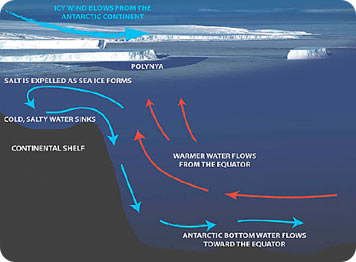Even to the untrained eye, it’s obvious that the waters of the world’s oceans aren’t the same. The crystalline waters of the Caribbean don’t look at all like the muddy waters off the mouth of the Amazon River.
 Cold, salty water forms in near Antarctica and flows to the ocean floor. Credit: Dr. Matthew England
Cold, salty water forms in near Antarctica and flows to the ocean floor. Credit: Dr. Matthew EnglandThe difference isn’t limited to the surface, though. In fact, different water masses are stacked atop each other like the layers of a cake.
The layer at the bottom of much of the world’s oceans is known as Antarctic Bottom Water. It’s the coldest and densest water on the planet. And even though it’s born in the Antarctic, it underlies parts of the Atlantic, Indian, and Pacific oceans.
Antarctic Bottom Water forms beneath the winter ice pack in the seas around Antarctica. As the surface water freezes, most of its salt leaches into the water below the ice. That creates a salty brew that’s chilled to about 30 degrees Fahrenheit. This water flows down the continental slope all the way to the ocean floor -- more than two miles down.
Some of this water migrates into the surrounding basins. It generally flows as far north as the equator, but it can flow even farther: Antarctic Bottom Water has been sampled in the Arctic waters around the Aleutian Islands.
Oceanographers can determine how long it takes to make the journey by measuring the water’s oxygen content; old water has lost its oxygen to living organisms and chemical processes. These measurements show that some Antarctic Bottom Water has been flowing for more than 1500 years -- making it not only the coldest ocean water, but also the oldest.

